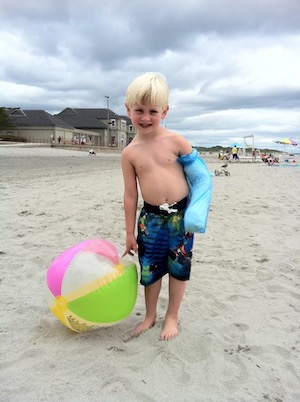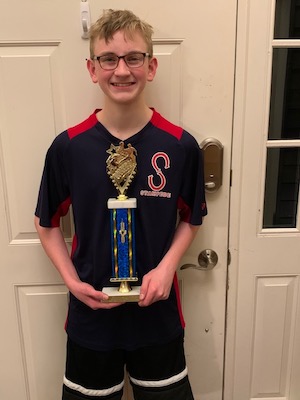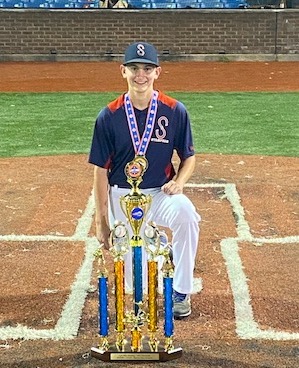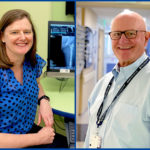A malunion fracture, baseball, and M&M cookies: Tyler’s story

Tyler Weygand loves baseball, and he’s good at it. Good enough that few balls ever get past him in the infield. So good that for nearly ten years, his parents and coaches in Saratoga, NY didn’t realize he could not rotate his left arm due to a malunion fracture.
A fracture that healed out of alignment

The issue with Tyler’s arm started when he was 4 years old and having a pillow fight with his cousin. He fell off the couch and heard both of the bones in his left forearm snap. A local doctor set the bones and put Tyler’s arm in a cast that went from his hand to his shoulder. A few weeks before the cast was to be removed, he tripped and fell on the arm. “We think that fall might have displaced the bones,” says April, Tyler’s mother. When the cast came off, a large bulge had formed where the fracture had been.
Because Tyler was young, his doctor said his bones would straighten out over time. Soon he returned to running and playing as he had before. When he was 7, he found baseball and became passionate about the sport. “Now when we look at pictures of him, we can see he was rotating his shoulder anytime he went to catch a ball,” says April. “But he was so good, nobody realized how much he was compensating for his arm.”
M&M cookies lead to malunion realization
The issue came to light when Tyler was 13. He was helping April make M&M cookies and she noticed he kept crossing the kitchen to pick up a few candies at a time. When she suggested he pick up a handful with his left hand, he told her he couldn’t cup anything in that hand.
A malunion fracture is a broken bone that heals abnormally. The affected limb may be bent, twisted, or both. A malunion can also impair function and mobility.
He held out his arms to show his mother what he meant. His right arm rotated easily one way and the other, but his left arm barely turned at all. A handful of M&Ms would have slipped right out of his palm.
“No scout will look at you if you can’t rotate your arm.”
Tyler had set his sights on playing professional baseball and dedicated himself to developing his skills. Now April and Tyler’s father, Brian, realized his arm would hold him back if they didn’t do something. “We told him, ‘No scout would look at you if you can’t rotate your arm,’” remembers April.

An orthopedic surgeon in Saratoga advised the family to seek care at Boston Children’s Hospital. “He told us the surgeons who wrote the book on how to treat Tyler’s type of fracture were there.”
In Boston, they met with Dr. Carley Vuillermin, a specialist in the Hand and Orthopedic Upper Extremity Program and Limb Lengthening and Reconstruction Program. An exam and x-rays revealed that the bones in Tyler’s forearm had grown curved and twisted in the years since the original injury. Dr. Vuillermin suggested a surgical procedure that would involve cutting both bones, rotating them, and securing them with screws and a metal plate while they healed.
“Dr. Vuillermin had just recently operated on a patient with a fracture a lot like Tyler’s,” says April. This gave her and Brian confidence that they were doing the right thing, but Tyler wasn’t so sure. For one thing, the operation sounded a lot more serious than he realized. For another, Dr. Vuillermin made it clear that it might not work.
“With any complex surgery it’s important for patients and families to know there are no guarantees,” explains Dr. Vuillermin. “But I would not have suggested the procedure if there wasn’t a likely chance of success.” To increase the chance of success, she used 3-D computer planning ahead of surgery to better understand Tyler’s specific anatomy and plan the exact cuts she would make during the procedure.
Malunion correction in the winter, varsity baseball in the spring
Tyler underwent surgery early in November 2020. He spent the next eight weeks in a cast, in pain, and worrying he would miss the start of baseball season.

Things started looking up when the cast came off in late December. He started physical therapy to rebuild his arm strength and the pain faded. When baseball season opened, he joined the varsity team. In August, Tyler was named most valuable player after his team went undefeated in a summer baseball tournament.
Looking back, Tyler says he’s glad he had the surgery. “When I was in pain, I said I’d never do something like that again. But now that my arm’s fixed, I’m very happy I did it.”
April is happy they took the extra time to travel to Boston Children’s. “We live four hours away, but it was worth it to find a doctor with experience treating this kind of fracture. And I think the people there really care about Tyler.”
She and Brian have always loved watching Tyler play baseball for the joy he takes in the game. Now they can also enjoy the ease with which he positions himself to intercept any ball headed his way.
Learn more about the Limb Lengthening and Reconstruction Program and Hand and Orthopedic Upper Extremity Program.
Related Posts :
-

Limb-lengthening surgery: A look at the pros and cons
Limb length discrepancies, a leg or arm that’s shorter than the other, can occur for a number of reasons. ...
-

A safe, pain-specific anesthetic shows preclinical promise
All current local anesthetics block sensory signals — pain — but they also interrupt motor signals, which can be problematic. For example, ...
-

After surgeries to treat HLHS, Carter is healthy and happy at home in Florida
Carter Miller loves action. The 4-year-old Florida resident enjoys riding on golf carts and flying high on swing sets. ...
-

Adam takes a pause from his active life for non-ossifying fibroma
Adam was 11 in early 2024 when he and his bike slid under a downed tree. Such events aren’t unusual for ...





